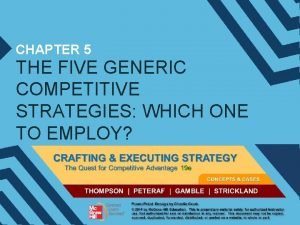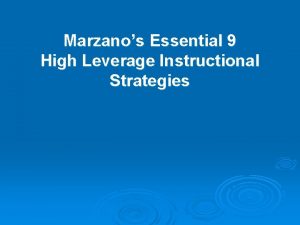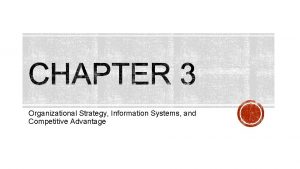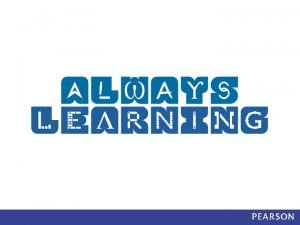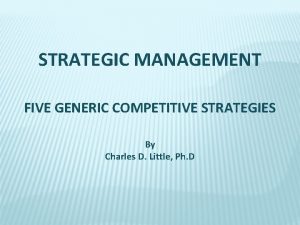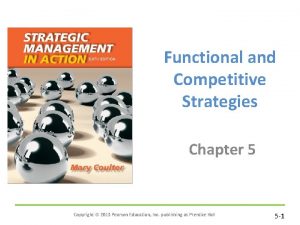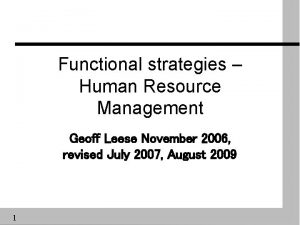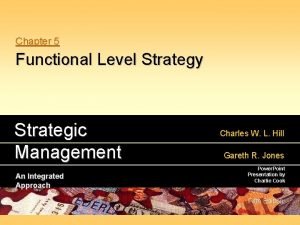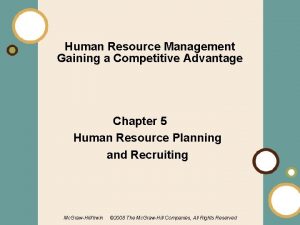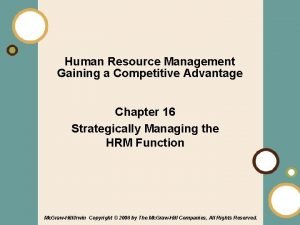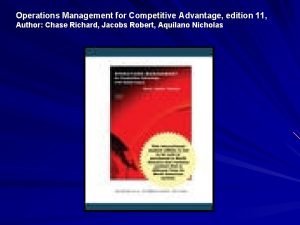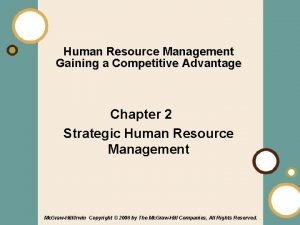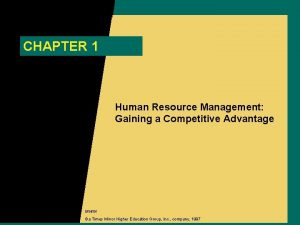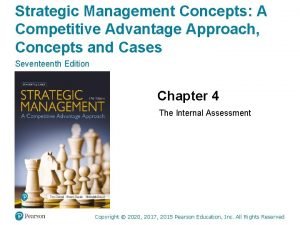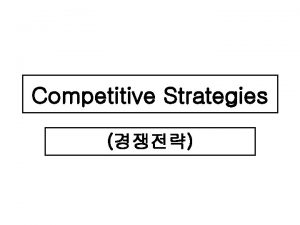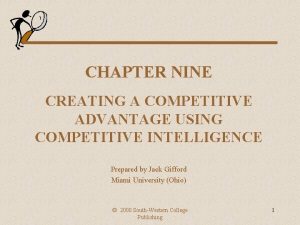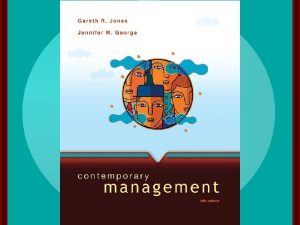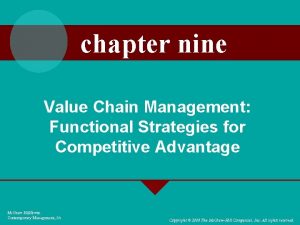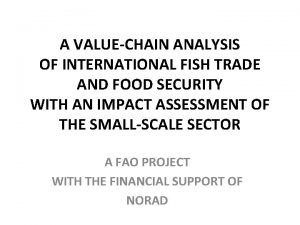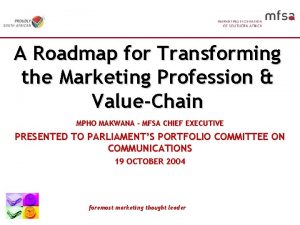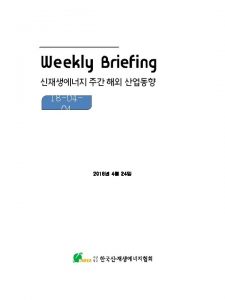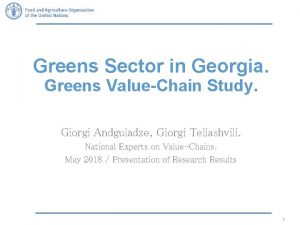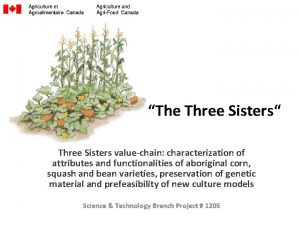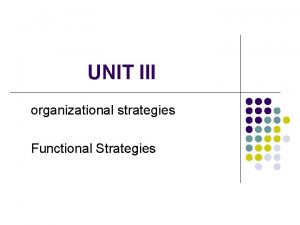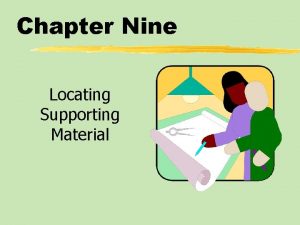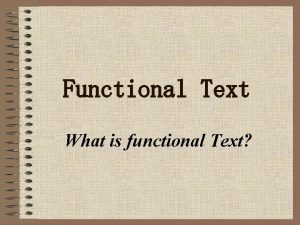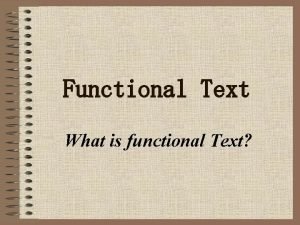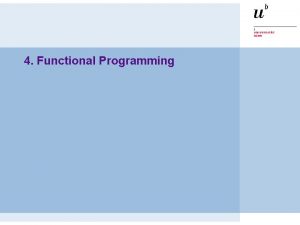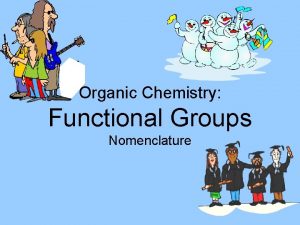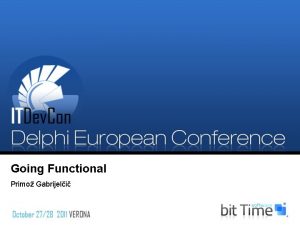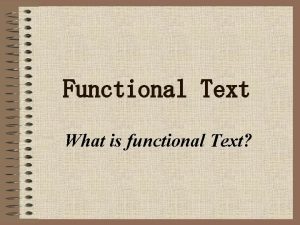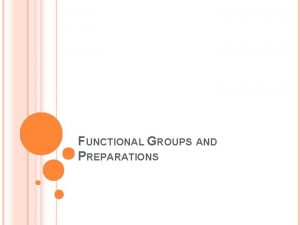Chapter Nine ValueChain Management Functional Strategies for Competitive
























- Slides: 24

Chapter Nine Value-Chain Management: Functional Strategies for Competitive Advantage Mc. Graw-Hill/Irwin Copyright © 2009 by The Mc. Graw-Hill Companies, Inc. All rights reserved.

Four Ways to Create a Competitive Advantage Figure 9. 1 9 -2

Functional Strategies and Value-Chain Management Ø Functional-level strategy ≈ plan of action to improve the ability of each of an organization’s departments to performs its task-specific activities in ways that add value to an organization’s goods and services 9 -3

Functional Strategies and Value-Chain Management Ø Value chain ≈ coordinated series or sequence of functional activities necessary to transform inputs into finished goods or services that customers value and want to buy 9 -4

Functional Activities and the Value Chain Figure 9. 3 9 -5

9 -6

Functional Strategies and Value-Chain Management Ø Value-chain management ≈ development of a set of functional-level strategies that support a company’s businesslevel strategy and strengthen its competitive advantage 9 -7

Functional Strategies and Value-Chain Management Ø Product development ≈ engineering and scientific research activities involved in innovating new or improved products that add value to a product Ø Marketing function’s task is to persuade customers a product meets their needs and convince them to buy it 9 -8

Functional Strategies and Value-Chain Management Ø Materials management function ≈ controls the movement of physical materials from the procurement of inputs through production and into distribution and delivery to the customer 9 -9

Functional Strategies and Value-Chain Management Ø Production function ≈ responsible for the creation, assembly or provision of a good or service, for transforming inputs into outputs Ø Sales function ≈ plays a crucial role in locating customers and then informing and persuading them to buy the company’s products 9 -10

Functional Strategies and Value-Chain Management Ø Customer service function ≈ provides after sales service and support ≈ Can create a perception of superior value by solving customer problems and supporting customers 9 -11

What Do Customers Want? 1. A lower price to a higher price (more for same price or same for lower price) 2. High-quality products 3. Quick service and good after-sales service 4. Products with many useful or valuable features 5. Products that are tailored to their unique needs 9 -12

Customer Relationship Management Ø Customer relationship management ≈ technique that uses IT to develop an ongoing relationship with customers to maximize the value an organization can deliver to them over time 9 -13

Total Quality Management Ø Total quality management (TQM) ≈ focuses on improving the quality of an organization’s products and stresses that all of an organization’s value-chain activities should be directed toward this goal 9 -14

Steps to Successful TQM Implementation 1. Build organizational commitment to quality 2. Focus on the customer 3. Find ways to measure quality 4. Set goals and create incentives 5. Solicit input from employees 9 -15

Steps to Successful TQM Implementation (cont. ) 6. Identify defects and trace to source. 7. Introduce just-in-time (JIT) inventory systems. 8. Work closely with suppliers. 9. Design for ease of production. 10. Break down barriers between functions. 9 -16

Facilities Layout, Flexible Manufacturing, and Efficiency Ø Facilities Layout ≈ strategy of designing the machine-worker interface to increase production system efficiency Ø Flexible Manufacturing ≈ strategy based on the use of IT to reduce the setup costs associated with a product assembly process 9 -17

Just-in-Time Inventory and Efficiency Ø Just-in-time (JIT) inventory system gets components to the assembly line just as they are needed to drive down costs Ø Major cost savings can result from increasing inventory turnover and reducing inventory holding costs 9 -18

Self-Managed Work Teams and Efficiency Ø Self-managed work teams produce an entire product instead of just parts of it Ø Team members learn all tasks and move from job to job Ø Can increase productivity and efficiency 9 -19

Process Reengineering and Efficiency Ø Process Reengineering ≈ fundamental rethinking and radical redesign of the business process to achieve dramatic improvement in critical measures of performance § E. g. , order fulfillment 9 -20

Strategies to Promote Innovation and Speed Product Development Ø Product development ≈ management of the value-chain activities involved in bringing new or improved kinds of goods and services to the market ≈ Stage-gate development funnel forces managers to make choices among projects so that resources are not spread too thinly 9 -21

Boundary-Spanning Roles Ø Boundary-Spanning roles ≈ Interacting with individuals and groups outside the organization to obtain valuable information from the environment 9 -22

The Nature of Boundary-Spanning Roles Figure 9. 9 9 -23

Topics for Discussion and Action Ø 7. Re: a local store, restaurant, or supermarket, how could this business improve its responsiveness to customers? 9 -24
 Market commonality and resource similarity examples
Market commonality and resource similarity examples 5 generic competitive strategies
5 generic competitive strategies Which market is the least competitive
Which market is the least competitive Competitive antagonist
Competitive antagonist Functional strategies in strategic management
Functional strategies in strategic management Marzanos 9
Marzanos 9 Porters strategies
Porters strategies What are porter's four competitive strategies?
What are porter's four competitive strategies? Focused strategy
Focused strategy Five generic competitive strategies examples
Five generic competitive strategies examples Prospector strategy
Prospector strategy Space maintainer types
Space maintainer types Non functional plasma enzymes
Non functional plasma enzymes Enzymes
Enzymes Functional and non functional
Functional and non functional Functional strategy
Functional strategy Corporate level strategy types
Corporate level strategy types Human resources management gaining a competitive advantage
Human resources management gaining a competitive advantage Human resource management gaining a competitive advantage
Human resource management gaining a competitive advantage Human resource management gaining a competitive advantage
Human resource management gaining a competitive advantage Operations management for competitive advantage
Operations management for competitive advantage Human resource management gaining a competitive advantage
Human resource management gaining a competitive advantage Competitive manufacturing management
Competitive manufacturing management Human resource management: gaining a competitive advantage
Human resource management: gaining a competitive advantage Strategic management a competitive advantage approach
Strategic management a competitive advantage approach

